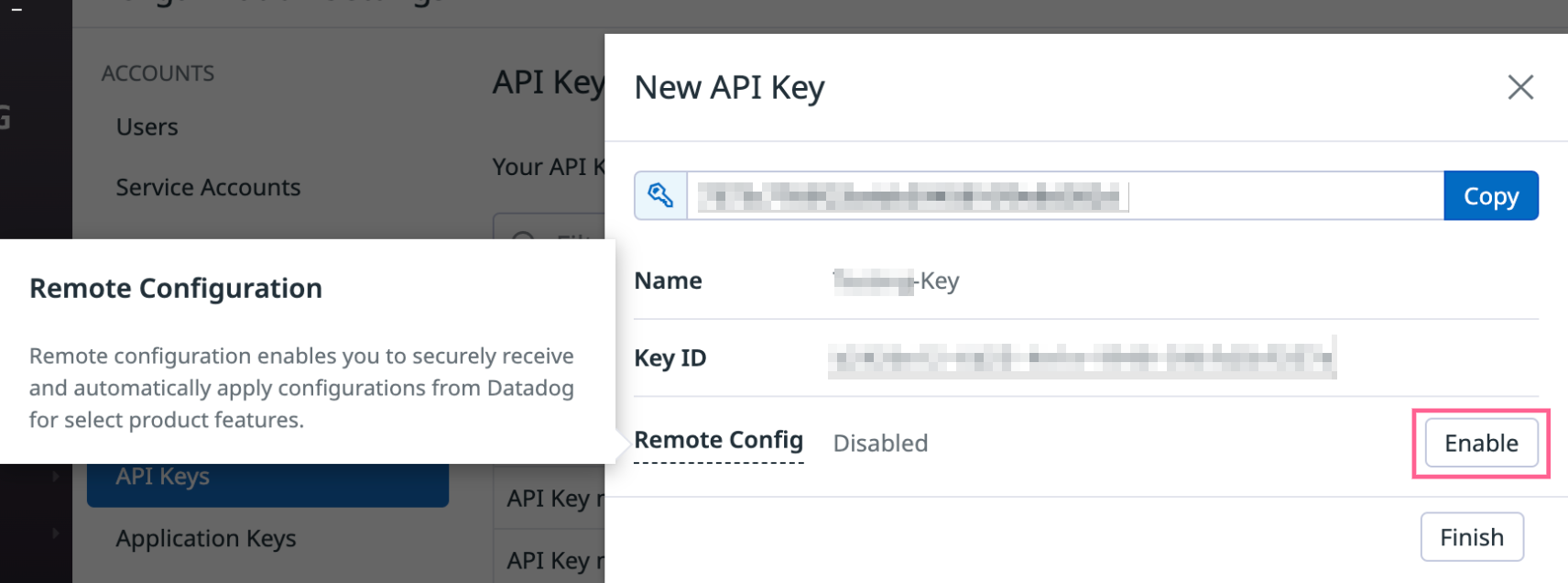- Essentials
- Getting Started
- Glossary
- Standard Attributes
- Guides
- Agent
- Integrations
- Developers
- Authorization
- DogStatsD
- Custom Checks
- Integrations
- Create an Agent-based Integration
- Create an API Integration
- Create a Log Pipeline
- Integration Assets Reference
- Build a Marketplace Offering
- Create a Tile
- Create an Integration Dashboard
- Create a Monitor Template
- Create a Cloud SIEM Detection Rule
- OAuth for Integrations
- Install Agent Integration Developer Tool
- Service Checks
- IDE Plugins
- Community
- Guides
- OpenTelemetry
- Administrator's Guide
- API
- Datadog Mobile App
- CoScreen
- CoTerm
- Remote Configuration
- Cloudcraft (Standalone)
- In The App
- Dashboards
- Notebooks
- DDSQL Editor
- Reference Tables
- Sheets
- Monitors and Alerting
- Metrics
- Watchdog
- Bits AI
- Software Catalog
- Error Tracking
- Change Tracking
- Service Management
- Actions & Remediations
- Infrastructure
- Cloudcraft
- Resource Catalog
- Universal Service Monitoring
- Hosts
- Containers
- Processes
- Serverless
- Network Monitoring
- Cloud Cost
- Application Performance
- APM
- Continuous Profiler
- Database Monitoring
- Agent Integration Overhead
- Setup Architectures
- Setting Up Postgres
- Setting Up MySQL
- Setting Up SQL Server
- Setting Up Oracle
- Setting Up Amazon DocumentDB
- Setting Up MongoDB
- Connecting DBM and Traces
- Data Collected
- Exploring Database Hosts
- Exploring Query Metrics
- Exploring Query Samples
- Exploring Database Schemas
- Exploring Recommendations
- Troubleshooting
- Guides
- Data Streams Monitoring
- Data Jobs Monitoring
- Digital Experience
- Real User Monitoring
- Synthetic Testing and Monitoring
- Continuous Testing
- Product Analytics
- Software Delivery
- CI Visibility
- CD Visibility
- Test Optimization
- Quality Gates
- DORA Metrics
- Security
- Security Overview
- Cloud SIEM
- Code Security
- Cloud Security
- App and API Protection
- Workload Protection
- Sensitive Data Scanner
- AI Observability
- Log Management
- Observability Pipelines
- Log Management
- Administration
Setting up Remote Configuration for Tracing
This guide covers setting up and using Remote Configuration with your tracing libraries. For more information on how Remote Configuration works, see Remote Configuration.
Prerequisites
- Datadog Agent 7.47.0 or higher installed on your hosts or containers.
- Upgrade your tracing libraries to a Remote Configuration-compatible version. For more information, see the Supported configuration options section.
- Ensure your RBAC permissions include
org_management, so you can enable Remote Configuration for your organization. - Ensure your RBAC permissions include
api_keys_write, so you can create a new API key with the Remote Configuration capability, or add the capability to an existing API key. Contact your organization’s Datadog administrator to update your permissions if you don’t have it. A key with this capability allows you to authenticate and authorize your Agent to use Remote Configuration. - Ensure you have the
APM Remote Configuration ReadandAPM Remote Configuration Writepermissions. Note: If you don’t have these permissions, ask your Datadog Admin to update your permissions from your Organization Settings.
Set up Remote Configuration
Ensure that Remote Configuration is enabled for your organization. This enables Datadog components across your organization to receive configurations from Datadog.
Select an existing API key or create a new API key, and enable the Remote Configuration capability on the key if it is not already enabled.
Restart your Agent.
Review Remote Configuration status of tracing libraries
You can gain visibility into the Remote Configuration status of your Tracer libraries through the Remote Configuration UI.
The following table describes the meaning of each Tracing library status:
| Tracing library Status | Description |
|---|---|
| CONNECTED | The Tracing library is successfully connected to the Remote Configuration service through the associated Agent. This is the optimal state you want your Tracing library to be in for Remote Configuration. |
| UNAUTHORIZED | The Tracing library is associated with an Agent which doesn’t have Remote Config Read permission on its API key. To fix the issue, you need to enable Remote Configuration capability on the API Key used by the Agent associated with the Tracing library. |
| CONNECTION ERROR | The Tracing library deployed in your environment is associated with an Agent that has remote_config.enabled set to true in its datadog.yaml configuration file, however, the agent cannot be found in the Remote Configuration service. The most likely cause of this is that the associated Agent is unable to reach Remote Configuration endpoints. To fix the issue, you need to allow outbound HTTPS access to Remote Configuration endpoints from your environment. |
| DISABLED | The Tracing library deployed in your environment is associated with an Agent that has remote_config.enabled set to false in its datadog.yaml configuration file. This could be set deliberately or mistakenly. To enable Remote Configuration on the associated Agent, set remote_config.enabled to true. |
| NOT CONNECTED | The Tracing library cannot be found in the Remote Configuration service and is associated with an Agent that could have remote_config.enabled set to true or false in its datadog.yaml configuration file. Check your local Agent configuration or your proxy settings. |
| UNSUPPORTED AGENT | The Tracing library is associated with an Agent which is not Remote Configuration capable. To fix this issue, update the associated Agent software to the latest available version. |
| NOT DETECTED | The Tracing library does not support Remote Configuration. To fix this issue, update the Tracing library software to the latest available version. |
| UNKNOWN | The Tracing library status is unknown, and it can’t be determined if an Agent is associated with the Tracing library. For example, this could be because the Agent is deployed on a fully managed serverless container service like AWS Fargate. |
Further reading
Additional helpful documentation, links, and articles:

